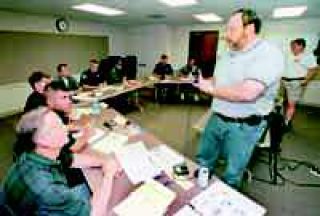SNOQUALMIE – Ever since the 6.8-magnitude Feb. 28 earthquake rendered most cellular phones and police radios in King County useless, Snoqualmie officials have been working to ensure a communications blackout doesn,t occur during future emergencies.
The city is buying dozens of hand-held ham radios, and city workers are taking classes on how to use them. The ham radios use a range of frequencies different from 800 megahertz police radio systems found throughout King County, which became overloaded and impossible to use shortly after the Nisqually Quake.
“During our last disaster, our earthquake, we discovered that the [police] radio was overloaded and it took a long time to make contact,” said Don Isley, chief of the Snoqualmie Department of Public Safety. He explained that the police radio system wasn’t down altogether, but everyone in the state was trying to use the same frequency at once, so it jammed up, “Like everyone pushing to get on to the bus.”
“In a disaster, it’s very important that we have communication,” he added. “All of a sudden we have to go out and find out what happened and what is damaged and who needs help. There are people out looking at the streets, bridges, water and the fire department goes around to check on citizens.
“Worst-case scenario would be somebody’s hurt and somebody needs attention, and we can’t get through, because phone lines and radios are down,” Isley said, adding that fortunately, nobody was seriously injured during February’s temblor. “So we had a list of issues we needed to talk about after our disaster, and one was looking for another form of communication.”
Ham radio, also called amateur radio, is the use of radio transmitters and receivers to communicate with other operators in the area and around the world. The ham radio is operated over short wave frequencies – 144 to 149 megahertz – which are separate from other broadcasters, including television and radio stations and fire and police organizations’ portable radios. Because the FCC set aside these frequencies for this purpose, only licensed ham operators can use them, so they’re always accessible. This is essential in any emergency or catastrophe.
The city will need about 40 to 50 radios, which cost about $150 apiece and will be purchased with funds from Snoqualmie’s emergency management budget.
About 60 percent of city workers will be trained in ham radio in the next few weeks. The majority of workers trained on ham radios are firefighters, police officers and public works employees, in other words, the people who are on the front line in an emergency and need to have contact with each other.
“Snoqualmie is the only city that I know of in Washington that is requiring [its] employees to learn ham radio,” said Gail Key, who is a King County Emergency Operations Center support team member.
“Yes, [the ham radio] is old fashioned and simple but it was the only tool that was working and not overloaded during the earthquake,” she said.
Ham operators, or “hams,” are licensed by the Federal Communications Commission, but are not allowed to hold public broadcasts or profit from use. Most operators use this type of communication as a hobby. They are known to help out their communities in time of disaster and storms.
A group of ham operators who belong to the King County Emergency Operations Center support team and live in Snoqualmie had already volunteered to serve as a communications network during the next disaster. But emergency personnel decided training all or most city workers to perform the same function would be an even better plan.
“We don’t think the ham radio is the answer to all the questions, but we think it will give us a backup solution,” Isley said. “We have to be responsible to the community and be prepared and be able to take care of any disasters that come forth.
“We just feel it’s needed. How can you take care of a disaster without communication?”
More communication between city employees will make Snoqualmie’s Emergency Operations Center (EOC) run more smoothly, said Jodi Warren, Snoqualmie’s clerk and public information officer. The center is activated during an emergency or disaster, and is located at the police station on Snoqualmie Ridge. There, Isley gathers with the mayor, City Council members and Warren, who last week completed her ham training and has an official license.
“With the EOC, you’re kind of on call 24 hours a day,” Warren said, explaining that after acquiring a license, Snoqualmie ham operators are given a radio to keep with them at all times.
The classes are taught by a team of five volunteer Snoqualmie residents, or “hams,” including Gail and Scott Key, Tony Annese, Sharon and Tim Vik, Mark Crouter, Judy Douglas, Frank Troutman, Snoqualmie police officer Bob Keaton and Gil Tumey, president of King County Search and Rescue. Each participant must attend three classes, then take a test to obtain their license and lifetime membership into the Maple Valley Wireless Society.


